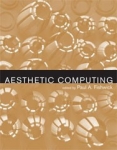May 15, 2006
Group Cognition

Innovative uses of global and local networks of linked computers make new ways of collaborative working, learning, and acting possible. In Group Cognition Gerry Stahl explores the technological and social reconfigurations that are needed to achieve computer-supported collaborative knowledge building--group cognition that transcends the limits of individual cognition. Computers can provide active media for social group cognition where ideas grow through the interactions within groups of people; software functionality can manage group discourse that results in shared understandings, new meanings, and collaborative learning. Stahl offers software design prototypes, analyzes empirical instances of collaboration, and elaborates a theory of collaboration that takes the group, rather than the individual, as the unit of analysis.
Stahl's design studies concentrate on mechanisms to support group formation, multiple interpretive perspectives, and the negotiation of group knowledge in applications as varied as collaborative curriculum development by teachers, writing summaries by students, and designing space voyages by NASA engineers. His empirical analysis shows how, in small-group collaborations, the group constructs intersubjective knowledge that emerges from and appears in the discourse itself. This discovery of group meaning becomes the springboard for Stahl's outline of a social theory of collaborative knowing. Stahl also discusses such related issues as the distinction between meaning making at the group level and interpretation at the individual level, appropriate research methodology, philosophical directions for group cognition theory, and suggestions for further empirical work.
21:50 Posted in Social Media | Permalink | Comments (0) | Tags: Positive Technology
Aesthetic Computing
From Amazon
In Aesthetic Computing, key scholars and practitioners from art, design, computer science, and mathematics lay the foundations for a discipline that applies the theory and practice of art to computing. Aesthetic computing explores the way art and aesthetics can play a role in different areas of computer science. One of its goals is to modify computer science by the application of the wide range of definitions and categories normally associated with making art. For example, structures in computing might be represented using the style of Gaudi or the Bauhaus school. This goes beyond the usual definition of aesthetics in computing, which most often refers to the formal, abstract qualities of such structures--a beautiful proof, or an elegant diagram. The contributors to this book discuss the broader spectrum of aesthetics--from abstract qualities of symmetry and form to ideas of creative expression and pleasure--in the context of computer science. The assumption behind aesthetic computing is that the field of computing will be enriched if it embraces all of aesthetics. Human-computer interaction will benefit--"usability," for example, could refer to improving a user's emotional state--and new models of learning will emerge.
Aesthetic Computing approaches its subject from a variety of perspectives. After defining the field and placing it in its historical context, the book looks at art and design, mathematics and computing, and interface and interaction. Contributions range from essays on the art of visualization and "the poesy of programming" to discussions of the aesthetics of mathematics throughout history and transparency and reflectivity in interface design.
21:45 Posted in Emotional computing | Permalink | Comments (0) | Tags: Positive Technology
May 14, 2006
South Korea develops next wave of virtual reality goggles
Via VRoot

Kowon Technology said the product would provide consumers with crystal clear video images alongside high-quality audio sounds that would be enjoyed privately through two liquid crystal display panels (LCD).
Read the full story on Yahoo! News
14:45 Posted in Virtual worlds | Permalink | Comments (0) | Tags: Positive Technology
Neurotech-art
Re-blogged from: Neurofuture
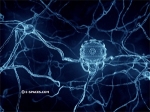
Philippe Van Nedervelde's E-spaces 3D Art Studio created Nanobots replacing neurons (nerve cells). This a still image of HD animation, depicting robots in the brain, from the transhumanist documentary Beyond Man (2005).
Although imaginary, current developments like MIT's nano neuro knitting experiment in which peptide nanofiber scaffolding was used to repair brain tissue in a hamster (article in PNAS) make it prescient.
Van Nedervelde's art is part of NANO, a virtual exhibit curated by transhumanist visionary Natasha Vita-More to showcase nanotech art by artists from a number of disciplines, including the multitalented Anders Sandberg. He's a computational neuroscientist and research associate at Oxford's Future of Humanity Institute.
Listen to a recent interview on the subject with Natasha Vita-More by RU Sirius from The MondoGlobo Network, as well as a podcast called Global Design and Nanotechnology from the (podcast archive alert!) Futures Podcast on Culture and Technology series.
14:40 Posted in Cyberart | Permalink | Comments (0) | Tags: Positive Technology
May 13, 2006
Spontaneous mentalizing during an interactive real world task: An fMRI study
Spontaneous mentalizing during an interactive real world task: An fMRI study.
Neuropsychologia. 2006 May 8;
Authors: Spiers HJ, Maguire EA
There are moments in everyday life when we need to consider the thoughts and intentions of other individuals in order to act in a socially appropriate manner. Most of this mentalizing occurs spontaneously as we go about our business in the complexity of the real world. As such, studying the neural basis of spontaneous mentalizing has been virtually impossible. Here we devised a means to achieve this by employing a unique combination of functional magnetic resonance imaging (fMRI), a detailed and interactive virtual reality simulation of a bustling familiar city, and a retrospective verbal report protocol. We were able to provide insights into the content of spontaneous mentalizing events and identify the brain regions that underlie them. We found increased activity in a number of regions, namely the right posterior superior temporal sulcus, the medial prefrontal cortex and the right temporal pole associated with spontaneous mentalizing. Furthermore, we observed the right posterior superior temporal sulcus to be consistently active during several different subtypes of mentalizing events. By contrast, medial prefrontal cortex seemed to be particularly involved in thinking about agents that were visible in the environment. Our findings show that it is possible to investigate the neural basis of mentalizing in a manner closer to its true context, the real world, opening up intriguing possibilities for making comparisons with those who have mentalizing problems.
20:07 Posted in Virtual worlds | Permalink | Comments (0) | Tags: Positive Technology
Virtual Reality in Google Trends
Visualizing the usage of the term "Virtual Reality" with the new Google Trends

(click here for larger image)
20:02 Posted in Virtual worlds | Permalink | Comments (0) | Tags: Positive Technology
MoBeeline
Via WMMNA

Chang Soo LEE and HyeJoo Lee have developed MoBeeline, a system that allows people to send data about a user's emotions to another's clothes via SMS.
From the project's web site:
MoBeeline is a compound word - Mobile + Beeline.
Our mobile service makes a straight line between two or more places.This project is an emotional mobile service based on wearable technology. The basic focus of this project is to stimulate people's emotions with an interaction between mobile and wearable technology, and to develop a social network service between friends.
The main goal is to create a wearable Bluetooth accessory that can receive data from a mobile phone. For example, let us assume that there are two mobile phone users. One user can send operative directions to the other's clothes as the user wants. Without the two users having to meet, they can share their feelings and emotions by sending signals to each other's clothes. Using our service, they will be changed the colors of each others garments, certain patterns or they can send emoticons to LEDs on the garment.
Watch the Video
19:54 Posted in Emotional computing | Permalink | Comments (0) | Tags: Positive Technology
World's Largest 3D-Display

From Networked Performance:
"Electrical engineering students at the Delft University of Technology in the Netherlands have created the world's largest 3D-display. The display consists of 8,000 suspended ping pong balls that each contain a red LED light. It play games of 3D snake, 3D pong, and 3D duckhunt, as wll as displaying SMS messages and simple animations"
19:48 Posted in Virtual worlds | Permalink | Comments (0) | Tags: Positive Technology
Female android developed by japanese team
Japanese scientists have unveiled the most human-looking robot yet - a "female" android named Repliee Q1Expo.

Watch the video of the android woman
19:45 Posted in AI & robotics | Permalink | Comments (0) | Tags: Positive Technology
Nanotubes used for first time to send signals to nerve cells
Via Medgadget
Researchers from the University of Texas Medical Branch and Rice University have succesfully tested the ability of carbon nanotubes to carry electrical signals to nerve cells. From the press release:
The group employed two different types of cells in their experiments, neuroblastoma cells commonly used in test-tube experiments and neurons cultured from experimental rats. Both cell types were placed on ten-layer-thick "mats" of single-walled carbon nanotubes (SWNTs) deposited on transparent plastic. This enabled the researchers to use a microscope to position a tiny electrode next to individual cells and record their responses to electrical pulses transmitted through the SWNTs.In addition to their electrical stimulation experiments, the scientists also studied how different kinds of SWNTs affected the growth and development of neuroblastoma cells. They compared cells placed on mats made of "functionalized" SWNTs, carbon nanotubes with additional molecules attached to their surfaces that may be used to guide cell growth or customize nanotube electrical properties, to cells cultured on unmodified "native" carbon nanotubes and conventional tissue culture plastic.
"Native carbon nanotubes support neuron attachment and growth well - as we expected, better than the two types of functionalized nanotubes we tested," Pappas said. [Todd Pappas, director of sensory and molecular neuroengineering at UTMB's Center for Biomedical Engineering -ed.] "Next we want to find a way to functionalize the nanotubes to make neuron attachment and communication better and make these surfaces more biocompatible."
Read the full press release
19:40 Posted in Neurotechnology & neuroinformatics | Permalink | Comments (0) | Tags: Positive Technology
Emotion's Defibrillator
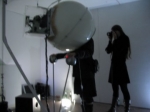
Tobias Grewenig's new installation Emotion's Defibrillator aims to explore how media affect our physiology:
The user of the installation, wearing an oxygen mask and a pincer on his left forefinger that will measure his/her pulse, puts his head into a big sphere. By placing the hands on two metalic spheres, the equipment is set in motion. First, bio data such as respiration, pulse and skin resistance are measured by the sensors and sent to the software to define the starting parameters. There are various sources of audio and a screen within the sphere. In relation to the data picked up from the body, the audio resonates, tiny electric shocks are delivered via the metallic spheres while the screen shows a flickering image of the user which is being interrupted by "subliminals". When the user takes the hands off the spheres, the installation stops.Grewenig says that it's fascinating to observe how the electronic equipment, although basically off-the-shelf material, starts frightening its user and turns into something profoundly unpredictable. This already happens when the sensoric input is roughly at the level of everyday city-life. (Well, plus electric shocks, that is.)
19:35 Posted in Cyberart | Permalink | Comments (0) | Tags: Positive Technology
Phone shui

According to Unwired View, Motorola has recently put forth a patent for the Feng Shui Phone, which has the following functionalities:
- Three-dimensional Hall-effect sensor for measuring the strength of electromagnetic fields and to form a compass to determine the geographic direction in which the main wall of the house faces.
- Digital camera to determine color saturation, order and balance of the surroundings.
- GPS receiver to determine geographic location of the phone.
- The coordinates are then sent to the GIS databse through wireless network to to get the information about the surroundings of the location, e.g. the distance from the undesirable sites such as major airports, landfills, and factories.
- Cellphone microphone is used to measure noise level of the location.
- AM/FM radio to measure the AM and FM transmission strength and the distance form nearest AM/FM towers.
- The table with the chi values of each parameter is stored in phones memory and is used for calculation of chi values of different parameters.
19:27 Posted in Wearable & mobile | Permalink | Comments (0) | Tags: Positive Technology
May 10, 2006
Toward direct biocontrol using surface EMG signals
Toward direct biocontrol using surface EMG signals: Control of finger and wrist joint models.
Med Eng Phys. 2006 May 6;
Authors: Reddy NP, Gupta V
Increased interest in virtual reality (VR) and telemanipulation has created a growing need for the development of new interfacing devices for measuring controlling actions of the human hand. The objective of the present study was to determine if surface electromyography signals (SEMG) from the flexor digitorum superficialis (FDS), and flexor carpi ulnaris (FCU) generated during flexion-extension of the human index finger and wrist can be used for controlling the flexion-extension of the finger and wrist of a simple geometric computer model. A simple geometric computer model of finger and wrist joints was developed. Eighteen subjects controlled the computer model using the SEMG signals from their FDS and FCU. The results indicate that the SEMG signals from the FDS and FCU muscles can be used as a direct biocontrol technique for controlling the finger and wrist models. This study establishes the proof of concept for direct biological control of the dynamic motion of the finger and wrist models for use in virtual reality environments and telemanipulation.
22:54 Posted in Virtual worlds | Permalink | Comments (0) | Tags: Positive Technology
Neural substrates for motor imagery in severe hemiparesis
Neural substrates for motor imagery in severe hemiparesis.
Neurorehabil Neural Repair. 2006 Jun;20(2):268-77
Authors: Kimberley TJ, Khandekar G, Skraba LL, Spencer JA, Van Gorp EA, Walker SR
BACKGROUND: . The beneficial effects of imagined movements on motor learning and performance suggest that motor imagery is functionally close to preparatory and executive motor processes. OBJECTIVE: . The purpose of this study was to examine the cortical processes associated with imagery of movement of the wrist in subjects with severe hemiparesis. METHODS: . During fMRI, subjects with stroke performed alternating blocks of imagining wrist-tracking movements with the hemiparetic hand, active wrist-tracking movements with the unaffected hand, and resting. Control subjects performed the same tasks using an assigned hand. Cortical activation in the primary motor (M1), primary sensory (S1), supplementary motor area (SMA), and pre-SMA regions was determined through a laterality index of active voxels and signal intensity. Ability to imagine was assessed with an Imagery Rating Scale. RESULTS: .All subjects displayed primarily contralateral control during the track condition. Healthy subjects demonstrated contralateral control in all areas during the imagine condition, whereas subjects with stroke displayed primarily contralateral activation in S1 but ipsilateral in M1 and SMA. The percentage change in signal intensity was greater in the ipsilateral hemisphere in subjects with stroke than in the ipsilateral hemisphere in healthy subjects during the imagine condition. Additionally, subjects with self-reported low ability to imagine displayed no difference in activation compared to those with high imagery ability. CONCLUSIONS: . These findings are consistent with other works demonstrating primarily ipsilateral control of the hemiparetic hand in subjects with functional movement and lay the groundwork for further investigation into the ability of mental imagery to affect functionally relevant cortical control in subjects recovering from stroke.
22:53 Posted in Mental practice & mental simulation | Permalink | Comments (0) | Tags: Positive Technology
VR-based schizophrenia training program
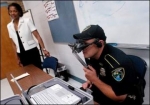
Janssen Pharmaceutical, a manufacturer of prescription medications for the treatment of schizophrenia and bipolar mania, has developed a schizophrenia training program based on virtual reality technology.
In the program, the participant chooses a virtual experience and is led through a range of visual and auditory hallucinations during a ride on a bus, a trip to the doctor's office or a trip to a pharmacy located in the back of grocery store.
In the virtual program simulating a trip to the pharmacy, the participant hears voices popping in and out of their head. Some are soft, some loud -- even yelling -- and many of them are paranoid. People stare at you from every aisle, some seem to be able to read your mind, others are afraid of you. A person in a television monitor screams at you. As you get to the pharmacy counter you can hear the pharmacists whispering and laughing and then they hand you a prescription of what looks like "poison," with a big scull and cross bones on the bottle's label.
22:44 Posted in Cybertherapy | Permalink | Comments (0) | Tags: Positive Technology
PaPeRo
Via Pink Tentacle
NEC has recently announced a technology that allows PaPeRo household robot to connect with a variety of personal devices. The technology provides PaPeRo with a digital avatar that “follows” you to the device of your choice, where it appears on the screen and interacts with you.
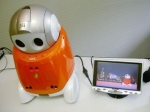
VIDEO of PaPeRo QuickTime, 1.24 MB
22:36 Posted in AI & robotics | Permalink | Comments (0) | Tags: Positive Technology
Enhanced humans
From New Scientist
People with enhanced senses, superhuman bodies and sharpened minds are already walking among us. Are you ready for your upgrade?They're here and walking among us: people with technologically enhanced senses, superhuman bodies and artificially sharpened minds. The first humans to reach a happy, healthy 150th birthday may already have been born. And that's just the start of it. Are you ready for your upgrade, asks Graham Lawton
IT IS 2050, and Peter Schwartz is deciding what to do with the rest of his life. He has already had two successful careers and he wants another one before he dies, which he expects to happen in around 50 years. By then he'll be about 150, which isn't bad for a baby boomer, but he expects his son, now 60, to live a lot longer than that.
The world that Schwartz lives in is radically different from the one he grew up in. The industrial and information age has passed into history, overtaken by a revolution in bioscience that began around
Link to the complete article
22:29 Posted in Brain training & cognitive enhancement | Permalink | Comments (0) | Tags: Positive Technology
Cognitive Development Research Assistant
Via Neurodudes
Applications are invited for the post of a Cognitive Neuroscience Research Assistant in the Department of Psychiatry & Behavioral Sciences. The RA will participate in several ongoing research studies of cognitive development and cognitive disorders (Alzheimer’s disease in particular).
Responsibilities include: assembling assessment instruments; screening and recruiting subjects; obtaining informed consent; scheduling subjects for testing; tracking progress of the study; designing fMRI and EEG experiments; acquiring, archiving and analyzing fMRI, MRI, DTI, EEG and behavioral data; verifying data and entering pertinent information into database for statistical analysis; and assistance with manuscript preparation. For creative and highly motivated candidates, the position offers plenty of opportunities to co-author publications.
QUALIFICATIONS:
*Requires a BS/BA degree in psychology, human biology, neuroscience, symbolic systems or related fields.
*One to two years of work experience is required.
*A strong academic record is essential; past research experience with fMRI and children and/ or elderly subjects is desirable.
*Experience with any of the following would be an added advantage: EEG, computer programming, statistical analysis, and neuropsychological assessment.
*The candidate must have strong organizational and interpersonal skills; the ability to work well with children and elderly subjects; a willingness to tackle complex tasks in an independent manner; and a strong sense of responsibility towards work.
Please call 650.736.0128 if interested. More information will be given (limited info here to avoid spam bots).
22:20 Posted in Research institutions & funding opportunities | Permalink | Comments (0) | Tags: Positive Technology
We Feel Fine
From We Feel Fine project's website

Since August 2005, We Feel Fine, An Exploration of Human Emotion, in Six Movements, has been harvesting human feelings from a large number of weblogs. Every few minutes, the system searches the world's newly posted blog entries for occurrences of the phrases "I feel" and "I am feeling". When it finds such a phrase, it records the full sentence, up to the period, and identifies the "feeling" expressed in that sentence (e.g. sad, happy, depressed, etc.). Because blogs are structured in largely standard ways, the age, gender, and geographical location of the author can often be extracted and saved along with the sentence, as can the local weather conditions at the time the sentence was written. All of this information is saved.The result is a database of several million human feelings, increasing by 15,000 - 20,000 new feelings per day. At its core, We Feel Fine - by Jonathan Harris & Sepandar Kamvar - is an artwork authored by everyone. It will grow and change as we grow and change, reflecting what's on our blogs, what's in our hearts, what's in our minds. We hope it makes the world seem a little smaller, and we hope it helps people see beauty in the everyday ups and downs of life.
22:18 Posted in Emotional computing | Permalink | Comments (0) | Tags: Positive Technology
Inside the Autistic Mind
Via Mind Hacks
The upcoming edition of Time Magazine has a cover story about autism. The story, entitled "Inside the Autistic Mind", is available online and discusses the recent developments in the psychology and neuroscience of autism.

22:08 Posted in Positive Technology events | Permalink | Comments (0) | Tags: Positive Technology







